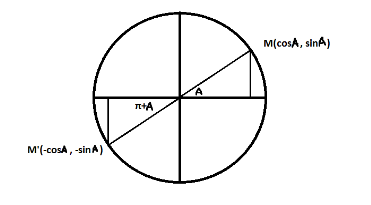
Answer
412.2k+ views
Hint: Imagine a unit circle and assume an angle, θ. Mark the corresponding coordinates $ (\cos \theta ,\sin \theta ) $ on the circle. The angle in the question is π more than the unknown angle. In the circle the coordinates corresponding to $ (\pi + \theta ) $ is $ ( - \cos \theta , - \sin \theta ) $ . Thus, we see the sine function for θ has changed to negative sine function upon addition of π.
Complete step-by-step answer:
Let us visualize a circle with unit radius and center at origin. Then we mark the angle A on the positive $ (x,y) $ axis. The corresponding point on the circle “M” is $ (\cos A,\sin A) $ . When the angle is changed to $ (\pi + A) $ , the point “M’” has the coordinates $ ( - \cos A, - \sin A) $ as they are located in the III quadrant, i.e., negative x and y axis.
And hence we see, $ \sin (A + \pi ) = - \sin A $ .

Alternate method: Using the identity of summation of angles in the sine function, we can also verify the above asked identity.
We know that, $ \sin (a + b) = \sin a.\cos b + \sin b.\cos a $
Putting $ a = \pi \& b = A $ in the above identity,
$ \sin (\pi + A) = \sin \pi .\cos A + \sin A.\cos \pi \\
Since
\sin \pi = 0 and \cos \pi = -1
we have
$ \sin (A + \pi ) = - \sin A $
Hence, verified.
Note: The functions sine, cosine and tangent of an angle are sometimes remarked as the primary or basic trigonometric functions. The remaining trigonometric functions secant (sec), cosecant (csc), and cotangent (cot) are defined as reciprocals of cosine, sine, and tangent, respectively. Trigonometric identities are equations involving the trigonometric functions that are true for each value of the variables involved.
Complete step-by-step answer:
Let us visualize a circle with unit radius and center at origin. Then we mark the angle A on the positive $ (x,y) $ axis. The corresponding point on the circle “M” is $ (\cos A,\sin A) $ . When the angle is changed to $ (\pi + A) $ , the point “M’” has the coordinates $ ( - \cos A, - \sin A) $ as they are located in the III quadrant, i.e., negative x and y axis.
And hence we see, $ \sin (A + \pi ) = - \sin A $ .

Alternate method: Using the identity of summation of angles in the sine function, we can also verify the above asked identity.
We know that, $ \sin (a + b) = \sin a.\cos b + \sin b.\cos a $
Putting $ a = \pi \& b = A $ in the above identity,
$ \sin (\pi + A) = \sin \pi .\cos A + \sin A.\cos \pi \\
Since
\sin \pi = 0 and \cos \pi = -1
we have
$ \sin (A + \pi ) = - \sin A $
Hence, verified.
Note: The functions sine, cosine and tangent of an angle are sometimes remarked as the primary or basic trigonometric functions. The remaining trigonometric functions secant (sec), cosecant (csc), and cotangent (cot) are defined as reciprocals of cosine, sine, and tangent, respectively. Trigonometric identities are equations involving the trigonometric functions that are true for each value of the variables involved.
Recently Updated Pages
How many sigma and pi bonds are present in HCequiv class 11 chemistry CBSE

Mark and label the given geoinformation on the outline class 11 social science CBSE

When people say No pun intended what does that mea class 8 english CBSE

Name the states which share their boundary with Indias class 9 social science CBSE

Give an account of the Northern Plains of India class 9 social science CBSE

Change the following sentences into negative and interrogative class 10 english CBSE

Trending doubts
Fill the blanks with the suitable prepositions 1 The class 9 english CBSE

Give 10 examples for herbs , shrubs , climbers , creepers

Change the following sentences into negative and interrogative class 10 english CBSE

Difference between Prokaryotic cell and Eukaryotic class 11 biology CBSE

The Equation xxx + 2 is Satisfied when x is Equal to Class 10 Maths

How do you graph the function fx 4x class 9 maths CBSE

Differentiate between homogeneous and heterogeneous class 12 chemistry CBSE

Application to your principal for the character ce class 8 english CBSE

Write a letter to the principal requesting him to grant class 10 english CBSE



